Rock’n Roll!
MEGAYACHT GALLIES
I will be far and far away when you read this article. Exactly in the middle of the Atlantic Ocean!
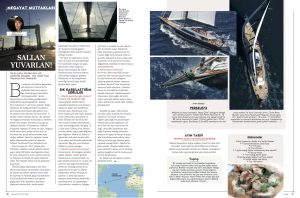 I am talking about Atlantic crossing with a superyacht. I am sure you previously read about the preparations for Atlantic crossing dozens of times. But I guess these preparations were for crossings with small sailboats. Small? Meaning boats maximum 15-20 meters long. Saying it like this may sound like I am underrating these boats, but what can we do sometimes… our yachts are really cool. That’s why they call them superyachts. Everybody has his/her own idea about the concept of superyachts and megayachts. Both 20-meter long motor yachts and 50-meter long motor yachts are called superyachts as well as. But in literature, Superyachts are 40 meters and longer while megayachts are 80 meters and longer. In this case, the sailboat I am rock’n rolling in is technically still a superyacht. However, an important superyacht in its class. I am talking about the sailboat Perseus^3.
I am talking about Atlantic crossing with a superyacht. I am sure you previously read about the preparations for Atlantic crossing dozens of times. But I guess these preparations were for crossings with small sailboats. Small? Meaning boats maximum 15-20 meters long. Saying it like this may sound like I am underrating these boats, but what can we do sometimes… our yachts are really cool. That’s why they call them superyachts. Everybody has his/her own idea about the concept of superyachts and megayachts. Both 20-meter long motor yachts and 50-meter long motor yachts are called superyachts as well as. But in literature, Superyachts are 40 meters and longer while megayachts are 80 meters and longer. In this case, the sailboat I am rock’n rolling in is technically still a superyacht. However, an important superyacht in its class. I am talking about the sailboat Perseus^3.
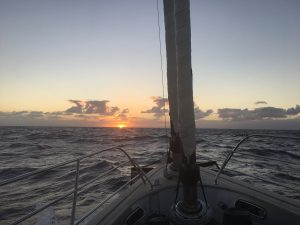 It is a new boat. It was launched in 2014. In addition to its 60-meter length which exceeds most sailboats, its magnificence lies in its mast, which is the third longest of the world and one-piece sail, which is the largest of the world. So don’t be very bedazzled with Maltese Falcon.
It is a new boat. It was launched in 2014. In addition to its 60-meter length which exceeds most sailboats, its magnificence lies in its mast, which is the third longest of the world and one-piece sail, which is the largest of the world. So don’t be very bedazzled with Maltese Falcon.
While the crew continued its technical preparations before beginning the ocean crossing, of course my part is to prepare the galley to the journey. The difference between Atlantic crossing preparations of superyachts and adventurous small sailboats is the vast difference between their storage spaces, the number of persons that the galley will serve being more numerous and expectations of these are a lot more than “fudging with canned foods”. This is the difficult part. As the bilge space of a 60-meter sailboat is huge enough to conduct horse races, it also acts as a storage. Here, two giant freezers are installed to the bilge space. The freezers and refrigerators are enough not even for Atlantic but Pacific crossings as well.
FREQUENTLY ASKED QUESTIONS
How many days it takes to cross the Atlantic?
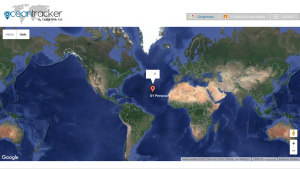 Depending on where you set off, traveling from a location in the Mediterranean to Gibraltar or Canary Islands generally takes between five-seven days; but it takes much longer if you are in Greek or Turkish Seas. After stopping in Gibraltar or Canary Islands and filling up fuel plus me restoring fresh ingredients, the real crossing takes between 12 to 14 days. Of course, this depends on the weather, your speed or whether the sails are unfurled or not. For example, we took from La Spezia – Italy two days ago, and I am writing this around Menorca. We will be reaching the Canary Islands in five days.
Depending on where you set off, traveling from a location in the Mediterranean to Gibraltar or Canary Islands generally takes between five-seven days; but it takes much longer if you are in Greek or Turkish Seas. After stopping in Gibraltar or Canary Islands and filling up fuel plus me restoring fresh ingredients, the real crossing takes between 12 to 14 days. Of course, this depends on the weather, your speed or whether the sails are unfurled or not. For example, we took from La Spezia – Italy two days ago, and I am writing this around Menorca. We will be reaching the Canary Islands in five days.
How do you maintain the freshness of vegetables?
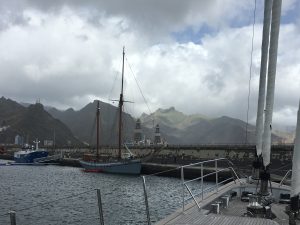 We don’t. The only vegetable I maintain is greens. Because, I purchase vegetables from Gibraltar or Canary Islands accordingly, and 12 days is not a long period. I am in trouble when there is not enough room in the refrigerator, and the vegetables eaten by 12 persons each day take a lot of space; then I use frozen vegetables if I have to. The most perishable foods are greens, parsley, herbs such as basil, bananas and avocados. The method for this is as follows: place paper towels inside to faces of large zip lock refrigerator bags and put the herbs or leaves in the bag dry, then we can easily maintain their freshness for two weeks by changing the towels every two days.
We don’t. The only vegetable I maintain is greens. Because, I purchase vegetables from Gibraltar or Canary Islands accordingly, and 12 days is not a long period. I am in trouble when there is not enough room in the refrigerator, and the vegetables eaten by 12 persons each day take a lot of space; then I use frozen vegetables if I have to. The most perishable foods are greens, parsley, herbs such as basil, bananas and avocados. The method for this is as follows: place paper towels inside to faces of large zip lock refrigerator bags and put the herbs or leaves in the bag dry, then we can easily maintain their freshness for two weeks by changing the towels every two days.
Do you fish?
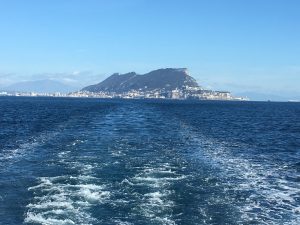 A lot of people ask whether we anchor and fish, and I usually answer with a question and a smirk “where do we anchor, to the ocean?”. But yes we fish. While we are sailing we tie two fishing hooks to the stern and continuously check them, so the one we cannot catch are the ocean’s but the others are all ours, in other words they become a feast for the crew in the form of sushi even sashimi, courtesy to us, the chefs.
A lot of people ask whether we anchor and fish, and I usually answer with a question and a smirk “where do we anchor, to the ocean?”. But yes we fish. While we are sailing we tie two fishing hooks to the stern and continuously check them, so the one we cannot catch are the ocean’s but the others are all ours, in other words they become a feast for the crew in the form of sushi even sashimi, courtesy to us, the chefs.
That’s all for now. The weather is bad, and I am trying to write while rock’n rolling… Although we are 60 meters long every piece of object is trying to leap up and stick into the other side; no, I am not joking. The wind is 30 knots, but it is not important, what matters is the swell, in other words the length of wave is so much that the boat shakes and dances uncontrollably like a drunkard that gulped down two bottles. Try to cross the Ocean this late and this definitely happens. Winter has come for the Mediterranean. As we will go to the southern hemisphere of the Atlantic following our stop at the Canary Islands, we will be immediately greeted by a hot summer.
Next month, I will be telling about the actual crossing, so see you…